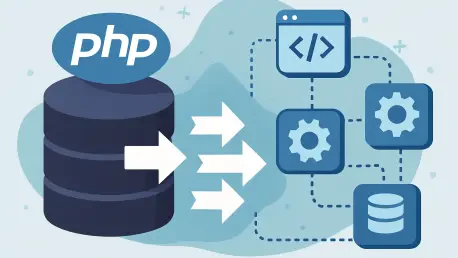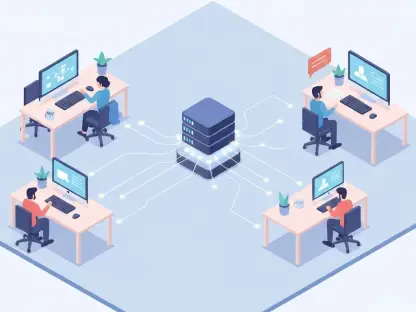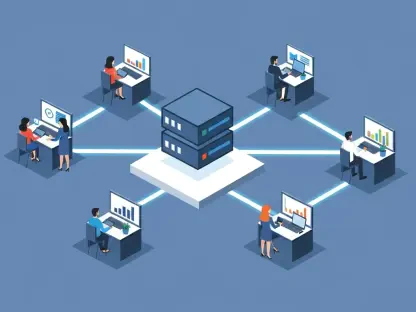In today’s fast-paced digital landscape, imagine a scenario where a growing e-commerce platform struggles to keep up with demand due to its outdated monolithic architecture. Every update takes weeks, bugs in one module crash unrelated features, and scaling the system feels like an insurmountable task. This is a reality for many businesses tethered to legacy systems, where the rigidity of a single, sprawling codebase stifles innovation. Fortunately, a solution exists in transitioning to microservices—a modular approach that can revitalize development processes. This guide aims to help businesses and developers navigate the complex journey of breaking down a monolith into manageable, independent services using PHP, a language often underestimated but incredibly powerful for such transformations. By following this roadmap, the goal is to achieve faster release cycles, improved scalability, and robust fault isolation.
The purpose of this guide is to demystify the migration process, providing a clear path for teams looking to modernize their systems. Microservices architecture allows for breaking applications into smaller, autonomous components, each handling a specific function, which can be developed, deployed, and scaled independently. This shift is not just a technical upgrade but a strategic move to enhance agility in competitive markets. PHP, with its mature ecosystem and modern frameworks, stands as a reliable choice for this endeavor, offering tools and community support to streamline the transition.
Beyond the technical aspects, the importance of this guide lies in addressing the operational and cultural shifts required for success. Adopting microservices impacts team structures, deployment practices, and even business decision-making. By focusing on practical steps and proven methodologies, this resource equips readers with the knowledge to tackle these challenges head-on, ensuring that the move away from a monolith becomes a sustainable, long-term win rather than a short-lived experiment.
Why Transition to Microservices: Unpacking the Need for Change
Monolithic architectures often serve as the backbone for early-stage applications, providing simplicity and ease of management when user bases and feature sets are small. However, as businesses expand, these systems reveal significant drawbacks. Slow release cycles emerge because even minor changes require redeploying the entire application, delaying critical updates. Additionally, debugging becomes a nightmare—untangling issues in a massive, interconnected codebase consumes time and resources, often leading to prolonged downtime.
Further complicating matters are the risks associated with updates in a monolithic architecture, where a single faulty change can bring down unrelated functionalities, impacting user experience across the board. Microservices address these pain points by decomposing the application into smaller, independent units. Each service focuses on a specific task, allowing teams to deploy updates without touching the broader system, thereby reducing risk and accelerating delivery timelines.
The relevance of PHP in this context cannot be overstated, as it continues to prove its worth in modern development environments. Often dismissed as outdated, PHP has evolved into a robust backend solution, particularly for microservices. Modern frameworks like Laravel and Symfony, combined with strong support for containerization and DevOps practices, make it a viable tool for building distributed systems. Its adaptability ensures that businesses can leverage existing PHP talent and infrastructure while embracing a service-oriented future, aligning technical capabilities with strategic growth.
The Case for PHP in Microservices: Strengths and Advantages
PHP’s resurgence as a credible option for microservices in the current tech landscape stems from its comprehensive ecosystem of frameworks tailored to diverse needs. Laravel offers a feature-rich environment ideal for complex services, while Lumen provides a lightweight alternative for stateless APIs. Symfony, with its modular components, supports long-term stability and clean code separation, making it suitable for enterprise-grade applications. This variety allows developers to select tools that match specific service requirements without overcomplicating the stack.
Another compelling advantage lies in PHP’s developer-friendly features that enhance productivity. Composer, the dependency manager, simplifies package integration across services, ensuring lightweight and maintainable codebases. Adherence to PHP Standards Recommendations (PSR) promotes consistent coding practices, facilitating collaboration among distributed teams. These standards, alongside built-in autoloading capabilities, enable seamless modular design, reducing friction when services need to operate independently or integrate with others.
Integration with DevOps tools further solidifies PHP’s position as a practical choice. Containerization with Docker and orchestration via Kubernetes are straightforward with PHP applications, enabling consistent environments from development to production. Compatibility with CI/CD pipelines through platforms like GitHub Actions or Jenkins supports automated testing and deployment, which are critical for the rapid iteration cycles of microservices. Additionally, the availability of skilled PHP developers in the market ensures that businesses can scale teams efficiently, leveraging a vast talent pool familiar with modern architectural patterns.
Your Migration Roadmap: From Monolith to Microservices with PHP
Transitioning from a monolithic architecture to microservices requires meticulous planning and execution. This roadmap breaks down the process into actionable steps, ensuring a structured approach to migration using PHP. Each phase addresses specific challenges, from identifying service boundaries to deploying and monitoring independent components, with practical insights to guide the journey.
The shift to microservices is not merely a technical overhaul but a transformation in how software is conceptualized and managed. By following these detailed steps, teams can mitigate risks associated with breaking apart a tightly coupled system. The focus remains on leveraging PHP’s strengths to build a resilient, scalable architecture that aligns with business objectives.
This guide prioritizes gradual change over abrupt disruption, advocating for the incremental extraction of services while maintaining system stability. The steps outlined below are designed to balance innovation with reliability, ensuring that each milestone builds toward a cohesive microservices ecosystem. With PHP as the foundation, the process becomes accessible even for teams with legacy systems predominantly built on this language.
Step 1: Identify Core Domains for Independent Services
The first step in migration involves dissecting the monolith by pinpointing distinct business functions that can operate as standalone services, ensuring a smoother transition to a more modular architecture. Areas such as authentication, user management, or order processing often emerge as natural candidates. Using Domain-Driven Design (DDD), clear boundaries can be established to prevent overlap, ensuring each service has a well-defined responsibility and minimal dependency on others.
Focusing on business logic rather than technical convenience is crucial during this phase. Mapping domains based on how the business operates—rather than how the code is currently structured—creates services that are meaningful and maintainable. For instance, separating inventory management from payment processing aligns with operational workflows, making future updates and scaling more intuitive.
This approach also sets the stage for long-term independence among services. By carefully delineating responsibilities early on, the risk of creating tightly coupled microservices—essentially replicating the monolith’s flaws—is minimized. Teams should invest time in stakeholder discussions to ensure that identified domains reflect real-world needs, laying a solid foundation for subsequent steps.
Step 2: Gradually Extract Modules Using the Strangler Fig Pattern
Once domains are identified, the next step is to isolate a single module from the monolith without disrupting the existing system, ensuring a smooth transition during the process. The Strangler Fig Pattern proves effective here—start with a non-critical module like payments or notifications, giving it a dedicated codebase and database. Internal function calls within the monolith should be replaced with API endpoints, whether HTTP, RPC, or GraphQL, to enable communication without direct dependency.
Testing the extracted service in parallel with the monolith is a prudent strategy to ensure stability, allowing for a seamless transition without risking system-wide issues. This dual-run approach enables validation of the new service’s functionality while the original system remains operational as a fallback. Only after thorough testing and confidence in the module’s independence should traffic be fully redirected, minimizing the chance of user-facing disruptions.
Gradual extraction also helps in managing team workload and learning curves. By focusing on one service at a time, developers can refine their approach to decoupling, API design, and deployment before tackling more complex components. This iterative process builds expertise and confidence, ensuring that each subsequent extraction benefits from lessons learned in earlier phases.
Step 3: Select the Right PHP Framework for Each Service
Choosing an appropriate PHP framework for each microservice is pivotal to balancing performance and functionality. For lightweight, stateless services such as authentication or logging, frameworks like Lumen or Slim offer speed and simplicity, avoiding unnecessary overhead. Conversely, services with intricate business logic, like order processing, benefit from robust options such as Laravel or Symfony, which provide extensive features for database management and caching.
Evaluating the specific needs of each service—whether prioritizing speed or comprehensive tooling—prevents over-engineering or performance bottlenecks. A stateless API endpoint might not require Laravel’s full suite of features, while a service handling complex workflows would struggle without Symfony’s structured components. This tailored selection ensures that resources are allocated efficiently across the architecture.
Additionally, consistency in framework usage can be balanced with flexibility. While maintaining a uniform tech stack simplifies maintenance, allowing variation based on service demands fosters optimization. Teams should document their rationale for framework choices to aid future developers in understanding the architecture’s design principles, promoting long-term coherence in the system.
Step 4: Containerize Services for Seamless Deployment
Containerization is a cornerstone of microservices deployment, and Docker provides a powerful solution for packaging PHP services into portable, isolated units. Each service, along with its dependencies, can be encapsulated in a container, ensuring that it runs consistently across different environments. Docker Compose facilitates local development by managing multi-container setups, simulating production conditions on developer machines.
For production environments, orchestration tools like Kubernetes take container management to the next level by handling scaling, load balancing, and failure recovery. Defining container configurations early in the migration process standardizes environments across development, testing, and live deployment. This consistency eliminates the common “it works on my machine” problem, streamlining collaboration and reducing deployment errors.
Containerization also enhances scalability, a key benefit of microservices. As demand fluctuates, Kubernetes can dynamically adjust the number of running containers for a specific service without affecting others. This flexibility, combined with PHP’s compatibility with container technologies, ensures that migrated services remain responsive to business needs, supporting growth without infrastructure overhauls.
Step 5: Define Inter-Service Communication Strategies
Effective communication between microservices is essential for a cohesive system, and strategies should be tailored to specific use cases. Synchronous methods like RESTful APIs or GraphQL suit real-time interactions where immediate responses are critical, such as user authentication or payment verification. These approaches provide straightforward integration but can introduce latency if overused in high-traffic scenarios.
For scenarios where immediate responses are not required, asynchronous communication using message queues like Kafka or RabbitMQ offers a decoupled, event-driven alternative. This method excels in handling background tasks, such as sending notifications or processing large data batches, allowing services to operate independently without waiting on each other. Choosing the right balance between synchronous and asynchronous methods prevents overloading APIs and ensures smooth workflows.
Careful planning of communication protocols also mitigates potential bottlenecks. Over-reliance on synchronous calls can create cascading delays during peak loads, while excessive asynchronous messaging might complicate debugging. Teams should map out interaction patterns during the design phase, establishing clear guidelines on when to use each approach to maintain system efficiency and reliability.
Step 6: Automate Deployment with CI/CD Pipelines
Automation is a lifeline for microservices, where frequent releases and multiple codebases demand efficiency, making it essential to streamline processes for optimal performance. Setting up CI/CD pipelines using tools like GitHub Actions, GitLab CI, or Jenkins enables continuous integration and delivery, reducing manual intervention. These pipelines automate building, testing, and deploying services, ensuring that updates reach production swiftly and reliably.
Incorporating comprehensive testing within these pipelines is non-negotiable. Unit tests validate individual components, while integration tests confirm that services interact correctly. Automated linting and security scans further enhance code quality, catching issues before they escalate. This rigorous testing framework embedded in the CI/CD process safeguards against deployment failures, maintaining system integrity across frequent updates.
Beyond technical benefits, CI/CD fosters a culture of rapid iteration and feedback. Developers can push changes with confidence, knowing that automated checks will flag discrepancies early. This agility aligns with microservices’ promise of faster development cycles, allowing businesses to respond promptly to market demands or user feedback without sacrificing stability or quality.
Step 7: Implement Observability for Proactive Management
The distributed nature of microservices introduces operational complexity, making observability a critical component from the outset. Tools like the ELK Stack centralize logging, aggregating data from all services for easy analysis. Monitoring solutions such as Prometheus paired with Grafana provide real-time metrics and alerts, offering insights into performance and resource usage across the architecture.
Error tracking platforms like Sentry enable proactive debugging by capturing and reporting issues as they occur. Setting up these observability tools early prevents undetected failures that could cascade through interconnected services. Without visibility, pinpointing the source of a problem in a distributed system becomes a daunting task, risking prolonged downtime and user dissatisfaction.
Observability also supports long-term optimization of the microservices ecosystem. By analyzing logs and metrics, teams can identify performance bottlenecks, optimize resource allocation, and predict potential failures before they impact users. This data-driven approach ensures that the system remains robust as it scales, providing a clear window into operational health at every stage of growth.
Avoiding Common Traps: Pitfalls and Best Practices
Migration to microservices is fraught with challenges that can derail progress if not addressed proactively, and overlooking these issues can lead to significant setbacks in the transition process. One common pitfall is attempting to migrate the entire monolith simultaneously, leading to chaos and system instability. A phased approach, extracting services incrementally, mitigates this risk. Another trap is using shared databases, which undermines service isolation and reintroduces coupling—each service should have its own data store to maintain autonomy.
Poor API documentation poses a significant hurdle, as microservices rely heavily on well-defined interfaces for interaction, and without clear, accessible documentation, integration becomes error-prone. This slows development and causes misalignments, making the process more challenging for teams. Similarly, neglecting service discovery mechanisms or robust testing infrastructure can result in services failing to locate each other or deploying with undetected bugs, compromising reliability.
To counter these issues, best practices include starting with non-core services like analytics for initial migrations, allowing teams to refine processes with minimal risk. Automating early through CI/CD pipelines streamlines repetitive tasks and enforces quality checks. Implementing centralized monitoring with tools like Prometheus and ELK Stack from the beginning ensures visibility into system health, enabling quick responses to issues and fostering a smooth transition.
Microservices in the Bigger Picture: Trends and Future Challenges
Microservices architecture aligns with broader industry trends emphasizing agility and adaptability in software development. By enabling teams to work on independent services, organizations can adopt diverse technologies best suited to specific tasks, breaking free from the constraints of a uniform stack. This flexibility not only accelerates innovation but also empowers cross-functional teams to take ownership of their domains, enhancing accountability and delivery speed.
Looking ahead, managing the operational complexity of microservices remains a persistent challenge. As the number of services grows, so does the need for sophisticated orchestration, monitoring, and security measures. Businesses must invest in tools and training to handle distributed systems effectively, ensuring that the benefits of modularity are not offset by unwieldy infrastructure demands or integration hurdles.
PHP continues to play a pivotal role in this evolving landscape, offering a practical foundation for scalable architectures. Its extensive framework support and compatibility with modern DevOps practices position it as a reliable choice for companies navigating these future challenges. As microservices adoption deepens, PHP’s accessibility and community resources will remain valuable assets for sustaining modular, resilient systems.
Final Reflections: Embracing Microservices with PHP
Reflecting on the journey, the migration from a monolith to microservices using PHP proved to be a transformative endeavor, marked by careful planning and strategic execution. Each step, from identifying core domains to implementing observability, contributed to building a system that offered flexibility, faster development cycles, and effective fault isolation. The process demanded attention to detail, but the outcome was a more agile and scalable architecture.
Moving forward, teams should consider deepening their investment in automation and monitoring tools to sustain the benefits achieved. Exploring advanced orchestration solutions or adopting emerging PHP libraries could further optimize service interactions and performance. Staying updated on community-driven advancements will also ensure that the system remains aligned with evolving best practices.
As a next step, engaging with PHP user groups or contributing to open-source projects related to microservices can provide fresh perspectives and solutions. Experimenting with additional services or refining existing ones based on user feedback will help in fine-tuning the architecture. This ongoing commitment to improvement ensures that the hard-won gains of migration continue to drive business success in a dynamic digital environment.









